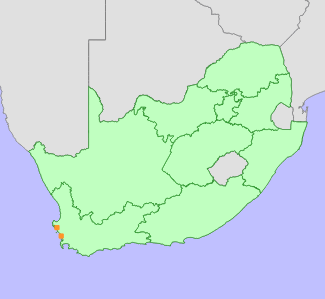|
Scientific Name | Erica trichostigma Salter |
Higher Classification | Dicotyledons |
Family | ERICACEAE |
National Status |
Status and Criteria | Critically Endangered B2ab(i,ii,iii,iv,v) |
Assessment Date | 2016/02/05 |
Assessor(s) | N.A. Helme & L. von Staden |
Justification | EOO 100-200 km², AOO <10 km², one, possibly two remaining subpopulations are threatened by habitat loss to development and competition from alien invasive plants. |
Distribution |
Endemism | South African endemic |
Provincial distribution | Western Cape |
Range | Langebaan to Mamre. |
Habitat and Ecology |
Major system | Terrestrial |
Major habitats | Cape Flats Dune Strandveld, Saldanha Flats Strandveld |
Description | Loamy sands over granite on coastal flats. |
Threats |
| There is ongoing development in the area surrounding the only known surviving subpopulation on the outskirts of Langebaan, which is endangering many local granite endemics. The subpopulation occurs on a site adjacent to the local landfill, but is currently only used for light grazing, and there are only minor infestations of alien invasive plants (N.A. Helme pers. obs. 2015). Habitat loss to development however remains a potential future threat. Competition from alien invasive plants is also likely to become a threat in future if current infestations are not controlled. Around Mamre, alien invasive plant infestations are severe, outcompeting native species, and is likely to threaten any surviving subpopulations in this area. There is also ongoing habitat loss to urban expansion to around Atlantis. One historical record suggests that this species occurs about 3 km south of Mamre, in which case it is likely to be locally extinct due to habitat loss to urban expansion. |
Population |
This species is known historically from only two locations: granite outcrops to the north-east of Langebaan on the Cape West Coast, where it was first discovered in 1935, and last recorded in 1985, until a surviving subpopulation was found in this area in 2015 (N.A. Helme pers. comm. 2015). This subpopulation is not currently threatened. There are also a number of collections from the vicinity of Mamre, about 60 km further south, where it was last seen in 1967. It is possibly already locally extinct in this area, as it has not yet been found again despite intensive surveys for rare and threatened plants around Mamre.
|
Population trend | Decreasing |
Assessment History |
Taxon assessed |
Status and Criteria |
Citation/Red List version | | Erica trichostigma Salter | CR B2ab(i,ii,iii,iv,v) | 2017.1 | | Erica trichostigma Salter | VU B1ab(ii,iii,iv,v)+2ab(ii,iii,iv,v) | Raimondo et al. (2009) | |
Bibliography |
Goldblatt, P. and Manning, J.C. 2000. Cape Plants: A conspectus of the Cape Flora of South Africa. Strelitzia 9. National Botanical Institute, Cape Town.
Manning, J.C. and Goldblatt, P. 2012. Plants of the Greater Cape Floristic Region 1: The Core Cape Flora. Strelitzia 29. South African National Biodiversity Institute, Pretoria.
Raimondo, D., von Staden, L., Foden, W., Victor, J.E., Helme, N.A., Turner, R.C., Kamundi, D.A. and Manyama, P.A. 2009. Red List of South African Plants. Strelitzia 25. South African National Biodiversity Institute, Pretoria.
Schumann, D., Kirsten, G. and Oliver, E.G.H. 1992. Ericas of South Africa. Fernwood Press, Cape Town.
|
Citation |
| Helme, N.A. & von Staden, L. 2016. Erica trichostigma Salter. National Assessment: Red List of South African Plants version 2024.1. Accessed on 2025/10/24 |
 Comment on this assessment
Comment on this assessment


